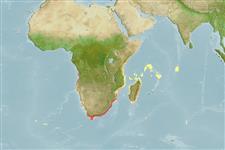Environment: milieu / climate zone / depth range / distribution range
Écologie
marin; saumâtre; océanodrome (Ref. 51243). Tropical
Southeast Atlantic: known only from Mossel Bay and the Kosi Estuary in South Africa. Reported from Angola (Ref. 3468) and Mozambique (Ref. 12484).
Length at first maturity / Taille / Poids / Âge
Maturity: Lm 38.0 range ? - ? cm
Max length : 75.0 cm TL mâle / non sexé; (Ref. 4393); poids max. publié: 3.1 kg (Ref. 4699)
Épines dorsales (Total) : 5; Rayons mous dorsaux (Total) : 8; Épines anales: 3; Rayons mous anaux: 9.
Occur mainly in estuaries, congregating over mud-banks (Ref. 2830). Oviparous, eggs are pelagic and non-adhesive (Ref. 205). Omnivore (Ref. 97629). Fleshy highly esteemed (Ref. 4393).
Life cycle and mating behavior
Maturities | Reproduction | Spawnings | Egg(s) | Fecundities | Larves
van der Elst, R., 1981. A guide to the common sea fishes of southern Africa. C. Struik, Cape Town. 367 p. (Ref. 3670)
Statut dans la liste rouge de l'IUCN (Ref. 130435)
Menace pour l'homme
Harmless
Utilisations par l'homme
Pêcheries: intérêt commercial mineur; pêche sportive: oui
Outils
Articles particuliers
Télécharger en XML
Sources Internet
Estimates based on models
Preferred temperature (Ref.
123201): 18.5 - 26.3, mean 24.9 °C (based on 34 cells).
Phylogenetic diversity index (Ref.
82804): PD
50 = 0.5005 [Uniqueness, from 0.5 = low to 2.0 = high].
Bayesian length-weight: a=0.01445 (0.00822 - 0.02541), b=2.96 (2.81 - 3.11), in cm total length, based on LWR estimates for this species & Genus-body shape (Ref.
93245).
Niveau trophique (Ref.
69278): 2.5 ±0.16 se; based on food items.
Résilience (Ref.
120179): Faible, temps minimum de doublement de population : 4,5 à 14 années (Preliminary K or Fecundity.).
Fishing Vulnerability (Ref.
59153): Moderate to high vulnerability (50 of 100).
